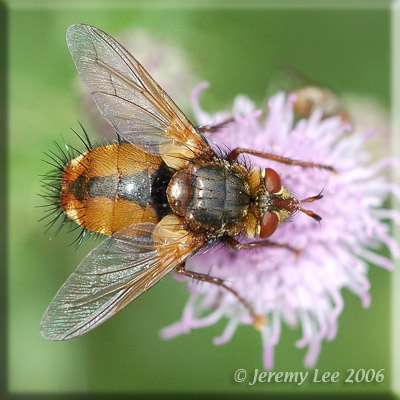
 |
|
Scientific Classifications explained » Amphibians » Ants » Aphids » Bees » Beetles » Birds » Bugs » Butterflies » Caterpillars » Damselflies » Dragonflies » Earwigs » Flies » Frog/Leafhoppers » Fungi » Galls » Grasshoppers » Harvestmen » Hoverflies » Lacewings » Ladybirds » Leaf Mines » Lichens » Mammals » Millipedes » Mosses » Moths » Sawflies » Slugs » Snails » Spiders » Trees & Shrubs » Wasps » Wild Flowers » Woodlice » Postboxes |
UK Nature > Flies > Tachina fera

Scientific Name: Tachina fera Common Name: Tachinid Fly Tachina fera, a Tachinid Fly, is a very common, large (9-16mm) and bristly fly with a prominent broad black stripe down the centre of an otherwise orange abdomen and with a wingspan of 16–27 mm. They are bristly on the thorax and abdomen, especially towards the tip, where they have long thorn-shaped, protruding black bristles. Close to the thorax there is a striking, orange-red and shiny 'bump' called postscutellum, with a thin black edge. The head is yellowish colored, with long antennae, whose second segment is yellow, while the third, much shorter, is black. The back of the head shows yellowish hairs and the large compound eyes are red in color. The size of the eyes in relation to the head is gender dependent. The palps of the mouthparts are long, thin and thread like. The wings are slightly yellow tinged, show a brownish yellow veining and are yellow brown at the base. Calyptrae are whitish yellow. The legs are predominantly yellowish, but in the male they are usually dark with a yellow tip. It can often be seen in moist and well vegetated locations where it feeds on umbellifers and waterside plants during May to September. The larvae are parasites of caterpillars and other young insects. Common and widespread in England and Wales. |
|

https://www.uknature.co.uk is a website dedicated to showing the immense diversity of UK nature and wildlife. Our vast range of habitats, from lowland arable to snow covered mountains, from storm-ravaged coastlines to peaceful inland freshwater lakes and rivers, from dry, sandy heaths to deciduous and coniferous forests, all these habitats contribute to the abundance of UK nature. We have wild birds in huge numbers either residing or visiting our shores (597 recorded species as at July 2013) and we must also not forget the humble back garden with its grass lawns, flower beds filled with nectar rich flowers, shrubs and trees, all designed to attract huge numbers of insects such as bees, moths, butterflies and hoverflies; and finally the small ponds which provide safe havens for frogs, toads, newts and even slow worms and grass snakes. www.uknature.co.uk is the showcase for my personal passion, photographing uknature in all its glory. I sincerely hope you all enjoy the fruits of my labours. This site and all images contained therein is © Jeremy Lee 2004 - 2025. All Rights Reserved. Site design by Jeremy Lee. Site development & IT Support by Stuart Lee. |